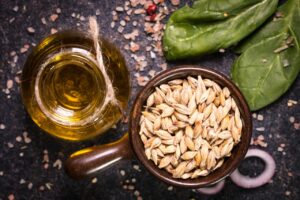Basil Vs Oregano. Basil does not have as much protein, vitamins, or minerals as oregano. Basil contains 12 times as much iron and 30 times as much Vitamin E as oregano. Basil, on the other hand, has higher quantities of vitamin C and vitamin A and is lower in carbohydrates, calories, and sodium.
People frequently mix up the two herbs oregano and basil. It can be challenging to distinguish between them because of how similar they appear, especially if you are a beginner cook.
Hence, what are the differences between basil and oregano? Basil and oregano both belong to the mint family. However, they differ in the following:
- Appearance: leaves and flower present different color and shape
- Growing conditions: oregano needs less water
- Life span: oregano lasts longer
- Taste: stronger for oregano
- Culinary purposes: different recipes although replaceable
read also: Kelp Nutrition Facts and Health Benefits
What Is Basil?
The plant known as basil, or Ocimum basilicum, is a member of the mint family and is a key component in many international dishes, including Italian, Thai, Indonesian, and Vietnamese.
It has been utilized for centuries and is renowned for its distinctive flavor and adaptability. The basil plant has religious importance as well; in Hinduism, it is known as Holy Basil.
The leaves of this herb are pointy and oblong, smooth, and deep green in color with numerous veins running through them. It tastes spicy and has a lovely, sweet scent.
Basil is quite simple to grow at home and is frequently found in kitchen gardens.
What Is Oregano?
The mint family also includes oregano, which is sometimes referred to as wild marjoram (in the Mediterranean) and Origanum vulgare, which means “joy of the mountain” in Greek.
It is a fragrant herb that has been utilized for both culinary and medicinal purposes for thousands of years.
Oregano is one of the most well-liked cooking herbs in the world and is a perfect complement to a range of foods, including pizza and pasta sauce. It is known for its mildly sweet, herbaceous, and earthy flavor.
read also; 10 People Who Should Never Drink Coffee, Say Dietitians
Italian, Turkish, Mexican, and Greek cuisine all heavily feature oregano. The majority of the time, dried oregano is marketed since fresh oregano may be very strong and overbearing.
What Is The Difference Between Basil And Oregano?
Although they may have a slight resemblance in appearance and both basil and oregano are herbs that belong to the mint family, they are completely different from one another.
They are easily interchangeable when used as dry herbs, especially for heartier and richer meals. Since their flavors will be stronger in lighter foods, their flavor distinctiveness is more noticeable.
Appearance
By attentively examining their leaves and blooms, you can distinguish between basil and oregano with ease!
The stem of basil is pale green, though it can also be purple or brown, depending on the type. Basil has smooth, round leaves that curl downward and can grow up to 4 inches long. When massaged, they give forth a powerful scent.
The stem of oregano is dark green or brown and coated in minute hairs. Oval in shape, oregano leaves have a pointed tip. They can reach a height of 2 inches and are slightly fuzzy due to the little hairs that surround the edges. They have a strong scent as well.
Both plants have flowers. Small, tubular blossoms on basil are typically white in color.
Read also: Raw Banana: Uses, Benefits, Side Effects and More
Flavor
Basil is regarded as a gentle herb with a sweet aroma and flavor. Depending on the cultivar, it might also have a powerful, peppery flavor.
Here are some of the most popular basil varieties along with descriptions of their flavors:
| Basil Variety | Flavor Profile |
|---|---|
| Sweet Basil | Fresh, subtly sweet flavor and aroma |
| Thai Basil | Spicy, anise-heavy flavor |
| Cinnamon Basil | Mild flavor with hints of spicy cinnamon |
| Purple Basil | Less sweet, known for its purple tone and clove-scented flavor |
On the other hand, oregano has a flavor that is strong and earthy with a delicate balance between sweet and spicy. Additionally, it has a mild bitterness that is similar to camphor.
Like basil, oregano is available in a variety of forms, each of which has a distinctive flavor profile.
Here are some of the most popular oregano varieties along with descriptions of their flavors:
| Oregano Variety | Flavor Profile |
|---|---|
| Mediterranean Oregano (Greek Oregano) | Mild taste and bold aroma |
| Mexican Oregano | Flavorful variety with strong peppery notes |
| Italian Oregano | Sweeter flavor that is ideal for seasoning |
| Cretan Oregano | Similar flavor profile to Greek oregano |
read also:12 Things That Happen to Your Body When You Eat Lemons
Culinary Uses
Italian cuisine uses basil frequently, but that’s not the only place it’s utilized! Additionally, it is extremely well-liked in Asian nations including Thailand, Vietnam, and Indonesia.
Combining this delicious herb with tomatoes for salads and sauces is a fantastic usage for it. Furthermore, it is perfect for flavoring vegetables and also works well for fish and poultry. Even basil tea is a possibility!
Popular herbs used in Italian, Mexican, Spanish, and French cooking include oregano and basil. It can be used in meals with olive oil or with tomatoes, just like basil.
Nutrition
Both basil and oregano have a comprehensive nutritional profile. Out of the two, oregano is richer in micronutrients and contains more carbs, protein, fiber, and fats. Basil, on the other hand, has fewer sugars.
Oregano also contains more calories than basil, while both contain no amount of cholesterol.
When it comes to the mineral content, oregano is richer and has a good amount of potassium, iron, calcium, zinc, and copper, while basil has a lower level of sodium.
read also: Kelp Nutrition Facts and Health Benefits
Basil Vs Oregano — Comparison Chart
Here is a detailed comparison of how these two popular herbs are similar and different from one another in terms of flavor, appearance, uses, nutritional value, and more.
| Basil | Oregano | |
|---|---|---|
| Botanical Family | Lamiaceae | Lamiaceae |
| Available In | Fresh and dried form | Fresh and dried form |
| Appearance (Leaves) | Dark green, red, or purple leaves that are oval-shaped and curl downward | Green leaves that are smaller and oval-shaped with a pointed end and tiny fuzzy hairs |
| Appearance (Flowers) | White flowers with light green stems that grow separately | Light pink or purple flowers with dark green or brown stems that grow in bunches |
| Taste And Aroma | Mixture of sweet and savory with notes of pepper, mint, clove, and anise | Grassy and earthy with a hint of spiciness and bitterness |
| Nutritional Value | Low in sugar and sodium, rich in vitamins C and A | Richer in micronutrients and vitamins |
| Uses | Used in Italian and Asian cuisine; tastes great with tomatoes, fish, and poultry | Used in Mexican and Mediterranean cooking; tastes great with vegetables and olive oil |
| Substitutes | Oregano, mint, tarragon | Basil, fresh thyme, parsley |
read also : Worst Things For Your Oral Health, Says Science
Nutritional Value & Health Benefits Basil & Oregano
Even while you may be confident that eating oregano and basil won’t damage you, you should be aware that they differ in terms of nutrients. Check out this table for a more thorough comparison of 100 grams of dried oregano and basil.
| Nutritions | Basil | Oregano |
|---|---|---|
| Energy | 233 kcal | 265 kcal |
| Protein | 23 g | 9 g |
| Total fat | 4.07 g | 4.28 g |
| Ash | 14.8 g | 7.87 g |
| Carbohydrate | 47.8 g | 68.9 g |
| Fiber | 37.7 g | 42.5 g |
| Calcium | 2240 mg | 1600 mg |
| Iron | 89.8 mg | 36.8 mg |
| Magnesium | 711 mg | 270 mg |
| Sodium | 76 mg | 25 mg |
| Vitamin B-6 | 1.34 mg | 1.04 mg |


